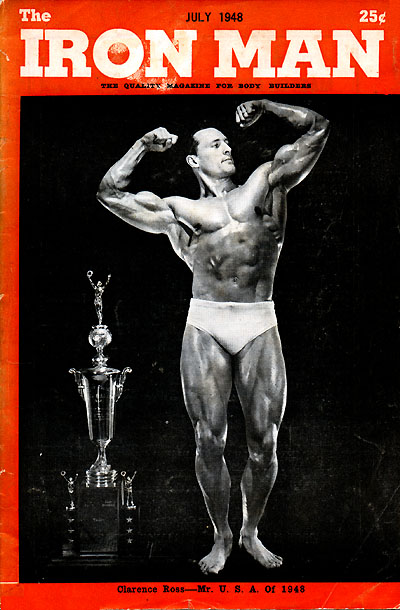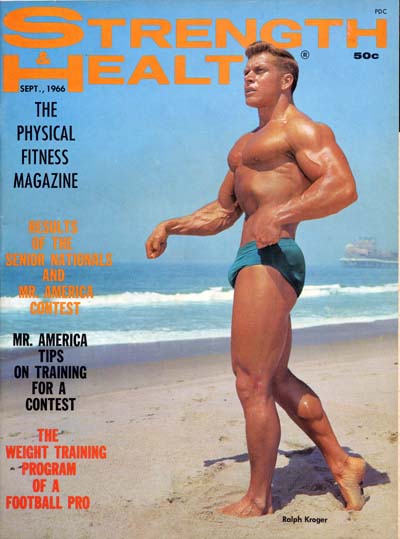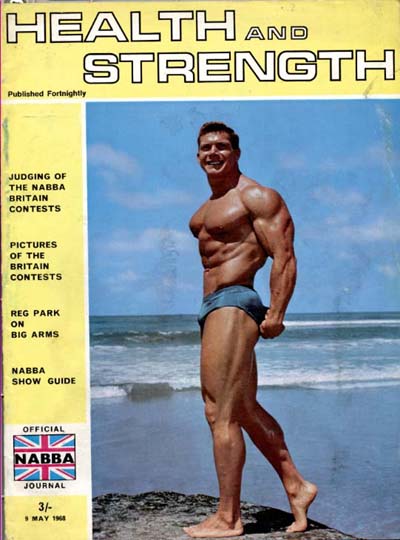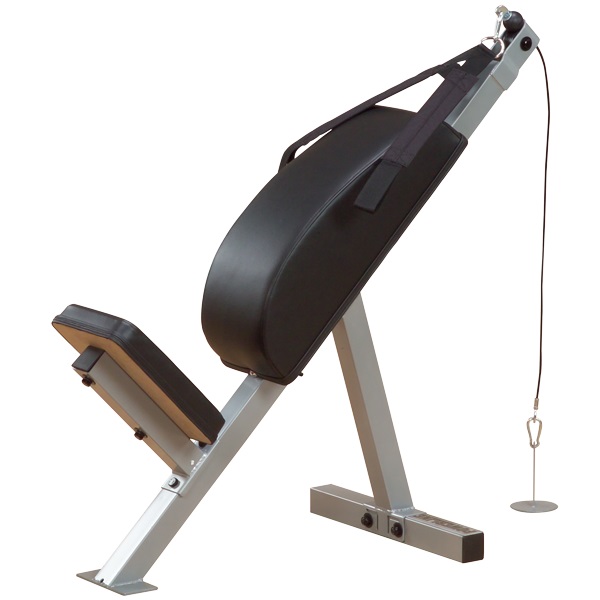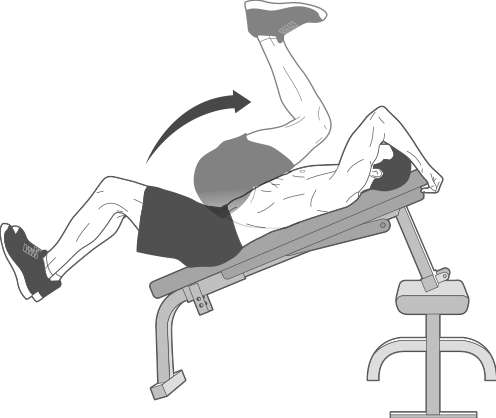First of all, it's important to know that I don't always stick with the same routine. I use a very instinctive approach, varying my workouts frequently. In spite of this, there is a general format I follow for my chest training, and approximately every six weeks it changes.
I train chest twice a week, usually with shoulders. Normally, my initial exercise is a pressing movement, most likely the barbell bench press. For this exercise I'm not concentrating on doing a power movement or lifting a heavy weight but rather on working the chest muscles as thoroughly as possible, getting a full extension and contraction, keeping my elbows out from my sides and bringing the bar down to a point high on my chest -- to about the top of my tank top.
For the bench press I use a medium grip because I find that if it's too narrow, I use too much triceps, and if it's too wide I lose the full length of movement to properly work the chest; therefore, I use a grip where at the bottom position my elbows are approximately 90 degrees.
At the bottom of the bench press movement I make sure I feel a stretch, maintaining tension all the way without letting the bar sink into my chest -- it barely touches. Then I explode it upward to a full lockout at the top. It's down slow and up fast, although, of course, the heavier the weight, the more I think about exploding from the bottom position.
At the most I do five or six sets of bench, including a warmup set. When I was lifting very heavy, I used to do five warmup sets. Now, even a high-rep warmup set can be a workout set if you do it hard enough, which is why I count it.
For all other exercises, however, I only do about four sets each. Three or four exercises are all I do for chest. Repetitions will be as low as six for the flat barbell benches, but for all other exercises I stay between eight and 12.
On benches I pyramid the weight and decrease reps. On all other exercises I usually increase the weight only once throughout the set. For example, I might do one set with a moderately heavy weight, then go up for the next set and keep it there for the remaining sets. However, I don't like to go below eight reps. If I can only do eight reps on one set, I drop the weight so I do at least eight on the next set. Conversely, if I can do 12 reps on a set, I add weight for the next set to bring down the reps.
Occasionally, I'll begin my workout with dumbbell bench presses. For this movement I again keep my elbows out wide to the sides, the dumbbells linear, not parallel, and with my palms facing forward. I do not turn my hands as I perform the movement; it's as though I'm holding a bar -- I feel this helps me get more of a stretch at the bottom. The only reason I might choose dumbbells over the barbell would be to get that stretch.
My second exercise is always an incline movement, usually a press. Normally, I choose to use dumbbells, especially if I just did a barbell movement, because I like to maintain that variety. I use a low incline, since I feel the high incline brings in too much of the anterior deltoid. As a powerlifter I was a deltoid presser, so I find it too easy to bring my delts into it. Now I try to keep them out of the movement as much as possible.
As in the flat bench press, I keep my elbows pointed out during the incline. Dropping your elbows in close to your body brings your deltoids into the exercise more, even on inclines.
Next, I do an exercise that is not a pressing movement, usually pec deck or flyes, normally flat but sometimes inclined and occasionally even declined. These I do almost straight-armed. I don't believe in bent-arm flyes. That takes away the value of doing flyes at all; you may as well do another press. To me, the value of the flye is the stretch you get at the bottom position and the tension you get on the outer pec as you start the movement upward from the bottom, as well as the squeeze at the top.
Because the flye is such a long movement, pulling out of the pecs, I don't use heavy weight because in the bottom position you're very vulnerable to injury. You have no long bar across the chest as you are pulling the pecs apart, so you have to be very careful in avoiding a tear.
At the bottom of the flye I try to stretch the dumbbells down below horizontal as much as I can and still be comfortable. It should not be a position of discomfort, but you should feel a definite stretch. I resist the temptation to bend my arms; they are stretched out wide. At full extension the dumbbell is in the lowest point, not my elbow. I also keep my arm at the same angle -- almost 180 degrees -- throughout the entire movement, even at the top where, by the way, I do not lock out to get that extra crimp. That I save for the pec deck, which I feel hits the inner pecs better when done properly.
From the bottom position of the flye, I try to move the dumbbells upward quickly but somewhat carefully until about halfway up, when the moment of force is not so great and the exercise becomes easier; then I slow up so they don't crash together. But the whole point of attempting to move the dumbbells upward as quickly as possible it so stretch the muscles even more, even though the movement itself might not be so fast.
On the pec deck I concentrate on bringing my elbows rather than my forearms together. I feel this gets the inner pec much better than a flye movement. I do not grip the top of the pad with my hands; instead I try to push with my elbows. I also keep my elbows high, at about the center of my pecs.
For any flye or pec deck movement I like to imagine a line from my sternum straight out in front of me a the plane through which my arms move, rather than have the movement begin from my shoulders. In other words, as I contract, I try to imagine my arms and pecs as one muscle or lever, with the power coming from my sternum rather than from my shoulders. I pull out and in front of my body, not into my chest.
Cables are also one of my favorites. I bend slightly forward and lean into the cables with my arms slightly less than perpendicular to my body so I am working the middle to lower section of my pecs. Cable work I do in three different formats: top together, top-across-to-bottom, and bottom-across-to top. I do them one arm at a time, which enables me to concentrate more on the specific pec being contracted.
Another exercise I do quite often is dips. At my gym we have a dipping machine with selectorized weights, which makes it much easier. On regular dipping bars I lean forward into them, with the apex of the bars in front of me. I arch my shoulders forward. Your shoulders should never move up and down; only your elbows should bend, and all the power should come from your chest. Think chest at all times, not triceps, shoulders or back. My grip is slightly out from my body, not so close as to work my triceps and not so wide as to work my shoulders. I do not use weight for dips. I find that dangerous and awkward. Instead, I do burnouts -- as many reps as possible for each set.
Often I will superset dips with incline dumbbell presses or, occasionally, incline flyes.
Rest periods between sets of any exercise are contingent upon whether I'm on- or off-season and upon how I feel I've recovered from the previous set. When I'm trying to build mass I rest until I feel I've fully recovered from the previous set, which can be anywhere from 30 seconds to 2.5 minutes. When I'm preparing for a contest, the rest period is always very short -- no longer than a minute at the most, most likely 30 seconds. But I don't sit there with a stopwatch. Remember, I do everything by feel.
When I'm doing a movement, I like to think in terms of very direct aggression against failure. I don't like doing repetitions to failure because I hate the failed rep. Instead, I will struggle like crazy to do the last rep I can possibly do on my own, which on the bench press might take five seconds or so, then stop, rather than take two seconds to do my last rep and then have someone help me with a few more. When I have had someone help me do a rep, I haven't felt as if it did that much good. In other words, it wasn't me who did it. I may have done a "bit of a rep," but how do you do a "bit"?
I also keep a very detailed record of everything I do. I've kept a training record since 1977 of every rep I've done, including every shock session, every lap I've run.
My husband Steve trains with me, and he's the only satisfactory training partner I've ever had. I hate to sound like so many bodybuilders who say, "I keep burning them out," but that's exactly what happened. Even when I was powerlifting, I had to tendency to train too fast. But I like to get into a rhythm and keep going.
Some of this has to do with the fact that I train so instinctively. Most training partners like to know before the start what we're going to be doing, but once I get into it, if something doesn't feel right that day, I might want to change, and that doesn't go down well with most training partners.
Steve, however, knows me so well and understands, so he is fully tolerant of such things. Plus, he's a big guy who just trains for strength, not competition. And he's much stronger than me, so it's nice to have someone around in whom I have absolute confidence.
On-season I keep my sets and reps the same, occasionally going from eight to 12 reps as high as 15, but primarily all I do is decrease rest periods and add more supersets. Also, rather than increase sets or reps, I might add another exercise so that instead of doing three or four movement, I'll do four or five.
I might also want to add the Nautilus press machine and the Icarian flye machine, which I have in my gym. Sometimes I might do decline dumbbell presses or decline flyes, but I don't do decline barbell presses because they hurt my shoulders.
Instinctive training for the chest may seem like chaos for some people, but for me it's just the opposite. It's using your head. It's scientific. And I am working all the muscles in the pectoral region thoroughly and from all angles. And I'm doing it safely, even though I train very heavy. A decade of covering the gamut from powerlifting to bodybuilding brought me to this point, and I'm not about to argue with empirical proof.



